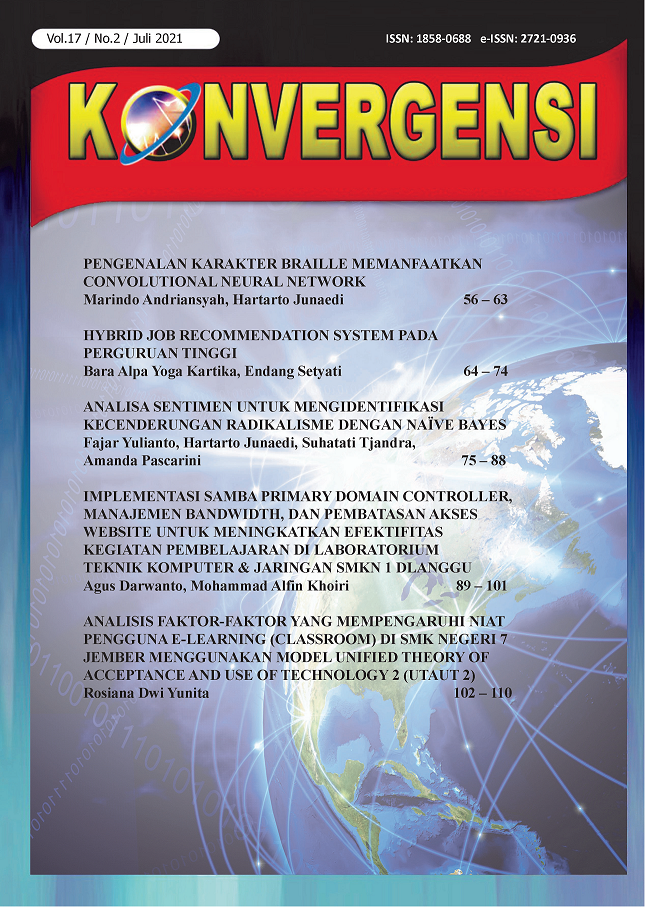ANALISIS FAKTOR-FAKTOR YANG MEMPENGARUHI NIAT PENGGUNA E-LEARNING (CLASSROM) DI SMK NEGERI 7 JEMBER MENGGUNAKAN MODEL UNIFIED THEORY OF ACCEPTANCE AND USE OF TECHNOLOGY 2 (UTAUT 2)
DOI:
https://doi.org/10.30996/konv.v17i2.5501Keywords:
Penerimaan Pengguna, E-learning, Unified Theory of Acceptance and Use of Technology 2 (UTAUT 2), Jenis Kelamin, Pendidikan Sebelumnya SiswaAbstract
ABSTRACT
To measure the factors that influence the acceptance of technology, then the Unified Theory of Acceptance and Use of Technology 2 (UTAUT 2) model is used where there is a change in the moderate variable, namely the student variable previous education and gender. Testing the model in this study using software SmartPLS. The results in this study are the factors that influence user intentions in using e-learning. It was found that the influencing factors were Performance expectancy is also referred to as performance expectations which have an influence on positive and significant on behavior intention in the behavior of using e-learning by student. This factor is proven to be the influence of students' intentions in using technology at SMK Negeri 7 Jember.
Keywords: User Acceptance, E-learning, Unified Theory of Acceptance and Use of Technology 2 (UTAUT 2), Gender, Previous education Students
ABSTRAK
Untuk mengukur faktor-faktor yang mempengaruhi penerimaan terhadap teknologi, maka digunakan model Unified Theory of Acceptance and Use of Technology 2 (UTAUT 2) yang dimana terdapat perubahan pada variabel moderat yakni variabel student previous education dan gender. Pengujian model dalam penelitian ini menggunakan software SmartPLS. Hasil dalam penelitian ini adalah faktor-faktor yang mempengaruhi niat pengguna dalam menggunakan e-learning. Diperoleh bahwa faktor yang berpengaruh adalah performance expectancy disebut juga sebagai ekspektasi kinerja dimana memiliki pengaruh positif dan signifikan terhadap behavior intention dalam perilaku penggunaan e-learning oleh siswa. Faktor inilah yang terbukti sebagai pengaruh niat siswa dalam menggunakan teknologi di SMK Negeri 7 Jember.
Kata Kunci: Penerimaan Pengguna, E-learning, Unified Theory of Acceptance and Use of Technology 2 (UTAUT 2), Jenis Kelamin, Pendidikan Sebelumnya Siswa
Downloads
References
Bachrudin, M. (2001). Communicative language teaching in Indonesia: issues of theoretical assumptions and challenges in the classroom practice. English Quarterly, 33(2), 63.
Brown, H. D. (2007a). Principles of language learning and teaching (5th ed.). New York: Pearson Longman.
Brown, H. D. (2007b). Teaching by principle: an interactive approach to language pedagogy (3rd ed.). New York: Pearson education , Inc.
Mustaqim, “Analisis Faktor-Faktor yang Memengaruhi Niat Penggunaan E_Commerce XYZ Menggunakan Model UTAUT (Unified Theory Acceptance and Use Of Technology) (Doctoral dissertation, Universitas Brawijaya),” Jurnal Pengembangan Teknologi Informasi dan Ilmu Komputer, vol. 2, no. 7, pp. 2584–2593, 2018.
A. M. Putranto and Y. Pramudiana, “Pengaruh Faktor-faktor Dalam Modifikasi Unified Theory Of Acceptance And Use Of Technology 2 Terhadap Perilaku Konsumen Dalam Mengadopsi Layanan Wifi.id Pt Telkom Area Jakarta,” e-Proceeding of Management, vol. 2, no. 2, pp. 1085–1094, 2015.
Rotikan and Aseng, “Identifikasi Faktor-Faktor Yang Mempengaruhi Mahasiswa Ilmu Komputer Dalam Mempelajari dan Menggunakan FrameworkPemrograman.,” CogITo Smart Journal, vol. 5, no. 1, pp. 79–88, 2019.
Y. Fan et al., “Applications of structural equation modeling (SEM) in ecological studies: an updated review,” Ecological Processes, vol. 5, no. 19, pp. 1–12, 2016.
Sugiyono, Metode Penelitian Kuantitatif, Kualitatif, dan R&D. Bandung: Penerbit Alfabeta, 2017.
S. Basiriyah, I. Listiowarni, and A. K. W. Hapantenda, “Analisis Penerapan Game-Based Student Response System Pada Flipped Classroom Biologi Sman 5 Pamekasan,” Konvergensi, vol. 16, no. 2, pp. 62–69, 2020.
A. Sanusi, Metodologi Penelitian Bisnis. Jakarta: Salemba Empat, 2016.
P. A. D. Putri and I. N. W. A. Putra, “Pengaruh Free Cash Flow Perusahaan Di Tahap Growth Dan Mature Pada Kebijakan Dividen,” E-Jurnal Akuntansi, vol. 20, no. 1, pp. 87–115, 2017.
Downloads
Published
Issue
Section
License
Authors whose manuscript is published will approve the following provisions:
- The right to publication of all journal material published on the Konvergensi Teknologi Informasi & Komunikasi website is held by the editorial board with the author's knowledge (moral rights remain the property of the author).
- The formal legal provisions for access to digital articles of this electronic journal are subject to the terms of the Creative Commons Attribution-ShareAlike (CC BY-SA) license, which means Konvergensi Teknologi Informasi & Komunikasi reserves the right to store, modify the format, administer in database, maintain and publish articles without requesting permission from the Author as long as it keeps the Author's name as the owner of Copyright.
- Printed and electronic published manuscripts are open access for educational, research and library purposes. In addition to these objectives, the editorial board shall not be liable for violations of copyright law.







